IAQ IQ Spring 2021
©2021 Jeffrey C. May
This is the 16th year that I’ve been sending newsletters to home inspectors and other building professionals. I am very committed to the home-inspection business, having been a home inspector myself for over ten years (and I have kept my membership in ASHI). I couldn’t have gone into the indoor air quality field without this prior experience, because an understanding of buildings and of HVAC systems is essential for any indoor air quality professional to have.
At the end of this article I am attaching a list of some of the newsletters I’ve sent out between 2012 and 2020. If any of you would like to receive copies of any of these earlier newsletters, please e-mail Connie (connie.may@comcast.net), and she will send them to you.
Now, onto the subjects at hand:
Bulkheads
Bulkheads made of plywood and trim are prone to decay from moisture and pest infestation. And it is very important to have a pest tight, airtight interior door at the bottom of bulkhead stairs, because spaces around and in the metal bulkhead doors offer rodent entry pathways. If there is no inner bulkhead door, recommend that one be installed ASAP. If you do not offer pest inspections, recommend that one be done.
The bulkhead area should be clean and free of debris, because moisture can collect there and lead to mold growth and decay. There should also be cementitious material or at least an airtight vapor barrier at the bottom of the bulkhead, because exposed soil releases moisture and contains microbial growth.
Porches
Three-season porches open to the exterior can be stained with mold growth on the ceiling and walls, and mold can also grow in carpeting (even the outdoor-type) and upholstered furniture that occupants choose to place in such porches. The most common kind of mold that I see on porch ceilings is Cladosporium: a black growth but not the much-feared Stachybotrys mold. Still, at the least such mold growth can be a cosmetic issue and at the worst, emit allergenic spores.
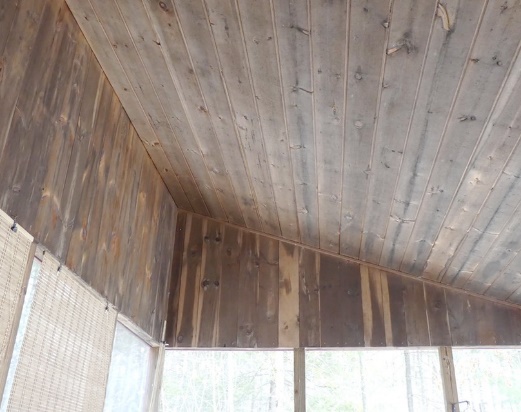
Mold needs nutrient and moisture, which can be liquid water or elevated relative humidity (RH). Unpainted wood has nutrients on the surface, and painted wood may be covered with biodegradable dust including pollen, mold spores, sap, and plant trichomes from the exterior. At night a porch’s roof loses heat to the universe due to radiational cooling, and the ceiling beneath cools, leading to elevated RH conditions and even condensation. It’s difficult to prevent mold growth on an open porch ceiling, but installing a ceiling fan to mix the air and installing insulation above the ceiling to reduce the heat loss can help minimize this problem. A coating of a mildewcide spray can also help.
Carpeting and upholstered furniture captures biodegradable dust including human skin scales and pet-dander particles. Mold then has the fodder it needs and will grow if moisture is present from spilled foods, humid outdoor air, or even body moisture. This is why I tell people who have a porch exposed to the exterior to avoid having any kind of rug out there and to use only solid-surface furniture that can be wiped clean and brought inside for the winter.
Even totally enclosed porches that are used as habitable spaces all year round can develop indoor air quality problems if they are constructed on posts and thus open to the exterior underneath. Such rooms can be “winterized” with fiberglass placed between the joists. If the fiberglass is not completely covered with a pest-impervious material such as plywood, rodents will move in (they love to nest in fiberglass), and then noxious odors can waft up into the enclosed porch. Bees can also nest in the fiberglass, which can be unpleasant to say the least, and even dangerous if any occupants or visitors have bee-string allergy. Enclosed porches must also be consistently heated during the winter and either air conditioned or dehumidified in the summer to help control the RH and thus help prevent mold growth.
Any dirt under an enclosed or open porch should be covered with a vapor barrier, and any lattice at the sides should have screening on the inside to help prevent insect entry. If rodents are a problem, hardware cloth can be installed behind the lattice and buried a few inches into the soil.
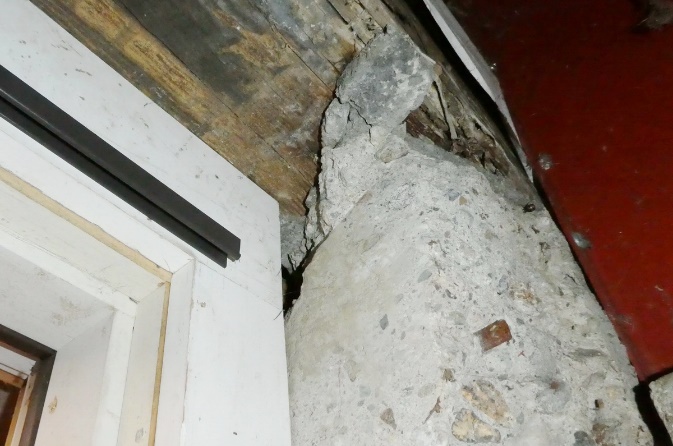
Decks
If a building lacks a roof overhang of at least 2 feet, there must be a gutter above a deck; otherwise, large amounts of roof water will pour onto the deck, and from there splash onto siding, a sliding door, or a threshold. If you suspect that roof water or wind-driven rain may have wet the threshold of a door leading from a house onto a deck, and the weather of the day of your inspection is dry, you can put a small amount of water from an eyedropper into the joint between the threshold and the vertical casing. If the water is sucked into the joint, hidden decay may be present.
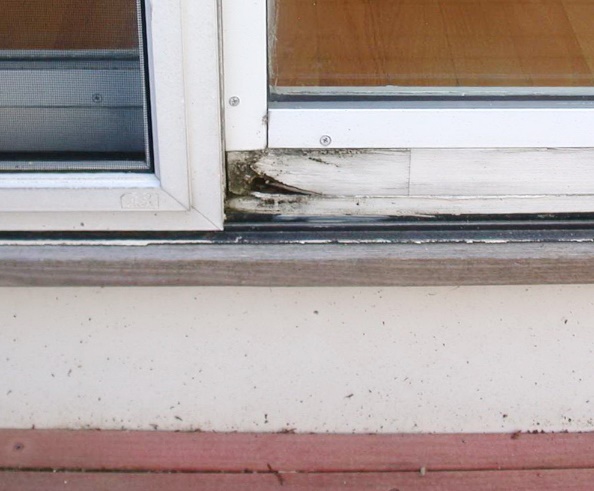
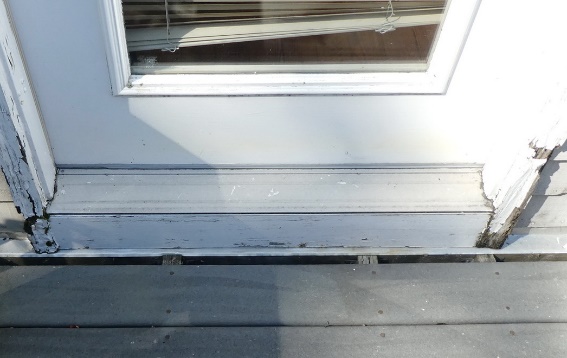
I’ll end this article with a story about some decks in a 6 building, 72 unit condominium complex. The association decided to have some re-siding work done; at the same time, the Board instructed the general contractor to inspect the decks for any repairs that may be needed. Guess what? Most of the decks were in such bad shape that the contractor told the Board to rope them off; otherwise, if more than 3 people had stood on any one deck, the deck could likely have fallen off the building.
What had caused all this decay? Important details had been left out in the construction, including pan flashings beneath the sliding doors leading to the decks. The joints between the casings of the slider openings and the thresholds were not water tight, so during wind-blown rain, water entered the framing. It’s no surprise, then, that in some units, a musty smell could be detected near those sliding doors.
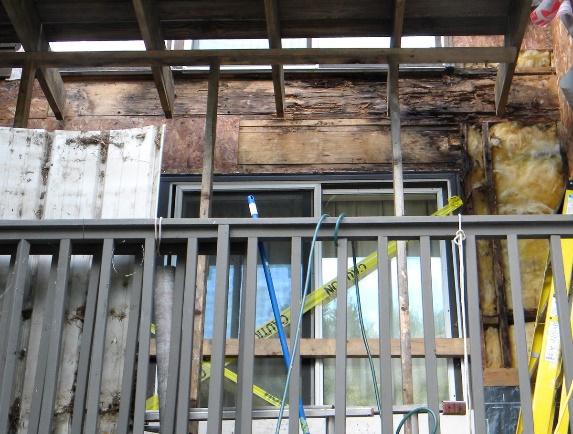
Here are some tips about porches, decks, and bulkheads you can share with your clients:
- Bulkhead doors should be made of metal.
- There should always be a pest tight, airtight inner door at the bottom of bulkhead stairs. There should be no spaces on top of or at the sides of such an inner door.
- In the absence of an adequate roof overhang, there must be a gutter system over a deck.
- Downspouts should not empty beneath a deck or porch.
- Any fiberglass insulation beneath a porch must have an airtight, pest tight cover such as plywood.
- Any dirt beneath a porch should be covered with a vapor barrier.
- Put screening behind lattice.

Titles of 20 of Jeff May’s “IAQ IQ” Newsletters sent from 2012 through 2020
(If you’d like copies of any of these, contact Connie – connie.may@comcast.net.)
- An Attached Garage – Blessing or Curse?
- Should There Be Fiberglass Below Grade?
- An Unexpected Source of Attic Moisture
- A Potentially Life-Threatening “Dehumidifier”
- The Chemical Mix of Indoor Air
- Ultraviolet Light Installations in Mechanicals
- Healthy Cooling Systems
- The Hidden Wonders of Finished Basements
- Ventilation Won’t Prevent Attic Mold Growth
- Risks of Below-Grade Fiberglass
- IAQ and Pests
- Cracks
- Case Studies of Building Odors
- Hashing Out Flashings
- Paint Failure Blues
- Lead Paint: Sweet It Ain’t
- Duck Duct Problems
- Mini-Splits
- Indoor Air Quality in a Multi-Unit Building
- Doing Inspections During a Pandemic
There are also copies of newsletters for both home inspectors and our clients on our website: www.mayindoorair.com – go to “Library.”
